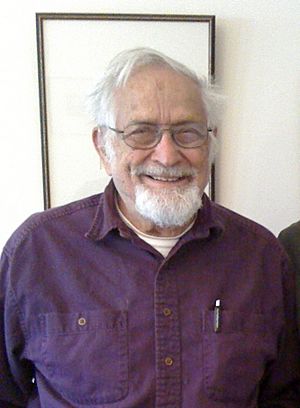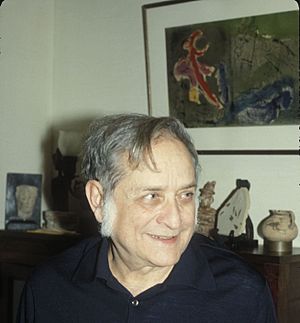Maurice Sanford Fox facts for kids
Quick facts for kids
Maurice Sanford Fox
|
|
|---|---|
 |
|
| Born |
Maurice Sanford Fox
October 11, 1924 New York City, New York, U.S.
|
| Died | January 26, 2020 (aged 95) |
| Nationality | American |
| Alma mater | University of Chicago |
| Known for | Molecular Biology, Genetic Mutation |
| Awards | Docteur Honoris Causa, Paul Sabatier University, Toulouse, France (1994) |
| Scientific career | |
| Fields | Molecular Biology |
| Institutions | Rockefeller Institute for Medical Research Massachusetts Institute of Technology |
| Doctoral advisor | Willard Libby |
| Doctoral students | David Botstein |
| Other notable students | H. Robert Horvitz |
Maurice Sanford Fox (born October 11, 1924 – died January 26, 2020) was an American scientist. He was a geneticist and molecular biologist. Dr. Fox was a professor at the Massachusetts Institute of Technology (MIT). He led the biology department there from 1985 to 1989.
His early work helped us understand how DNA enters and changes a cell. His research also taught us about how DNA can change (mutate). He was married to Sally Fox for over 50 years. They had three sons: Jonathan, Gregory, and Michael. Dr. Fox passed away in January 2020 when he was 95 years old.
Contents
Early Life and Learning
Maurice Fox, often called Maury, grew up in New York City. His parents were immigrants from Russia. He encouraged his sister, Evelyn Fox Keller, to study science too. Maury loved science from a young age. He started studying chemistry at Stuyvesant High School.
After a short time at Queens College, he joined the U.S. Army Air Force. He worked as a weather forecaster during World War II. After the war, he earned his Ph.D. from the University of Chicago in 1951. There, he met and became a close friend of Leó Szilárd, a famous scientist. Szilárd helped him get into the new field of molecular biology. In 1953, Maury joined a research group at the Rockefeller Institute for Medical Research.
This was an exciting time for science. Young, smart people from different fields worked together. They asked new questions about biology. This time is often called the "Golden Age of Molecular Biology." This period shaped Maury's research for many years. He kept asking new questions about genetics and cancer. He always believed in sharing ideas openly with others. He also cared deeply about helping young scientists. He felt it was important for scientists to help society.
Important Science Discoveries
Early in his career, Dr. Fox made a big breakthrough. He used something called "bacterial transformation" to study genetics. This helped him understand how genes change. He also studied how genes move between cells. This work was very important for understanding how DNA changes and repairs itself.
Dr. Fox always encouraged scientists to question what they knew. He wanted them to think of new ways to explain things. He also pushed them to design experiments to test these new ideas. This way of thinking helped many other scientists. For example, it led to the discovery of RNA viruses and the SOS response in bacteria. It also led to new ways of combining bacterial cells.
He also used his critical thinking to challenge common medical beliefs. For instance, he questioned the best ways to treat breast cancer. He also realized early on how important "epigenetic changes" are. These are changes that affect how genes work, even without changing the DNA itself. He saw their role in the first steps of cancer.
Making a Difference in Society
From the very start of his career, Dr. Fox thought about how science affects society. He worried about the effects of radiation. He also worried about the dangers of biological weapons. Later, he thought about the risks of gene therapy. He worked hard to make sure science was safe for everyone.
He talked to groups of citizens and gathered other scientists. He wrote articles and letters for science magazines. He also joined important committees. For example, he led the Radiation Protection Committee at MIT in the 1960s. He was also a member of the International Bioethics Committee of UNESCO starting in 1998.
Perhaps his most important social work was helping Leó Szilárd create the "Council for a Livable World" in 1962. This group was first called "Council for Abolishing War." It was one of the first groups to support political candidates who worked for peace. It helped elect many peace-focused leaders in the 1960s and 1970s.
Awards and Honors
- 1959. Lalor Award.
- 1963. Fellow, American Association for the Advancement of Science
- 1980. Member, Institute of Medicine
- 1988. Member, United States National Academy of Sciences
- 1991. NIH Fogarty International Center Fellowship
- 1992. Fellow, American Academy of Microbiology
- 1995. Fellow, American Academy of Arts and Sciences
- 1994. Docteur Honoris Causa, Paul Sabatier University, Toulouse, France
- 1998. Member, International Bioethics Committee of UNESCO


